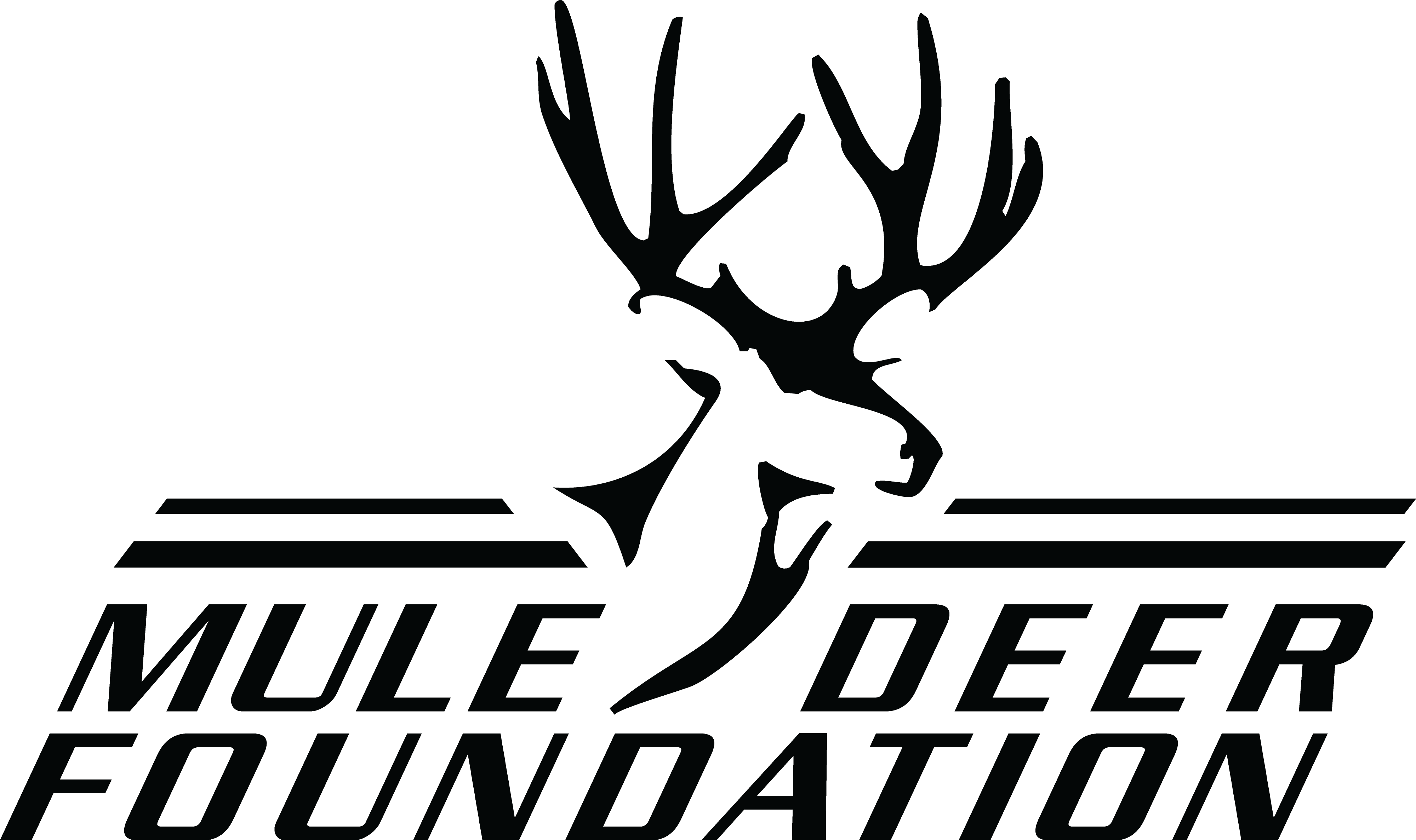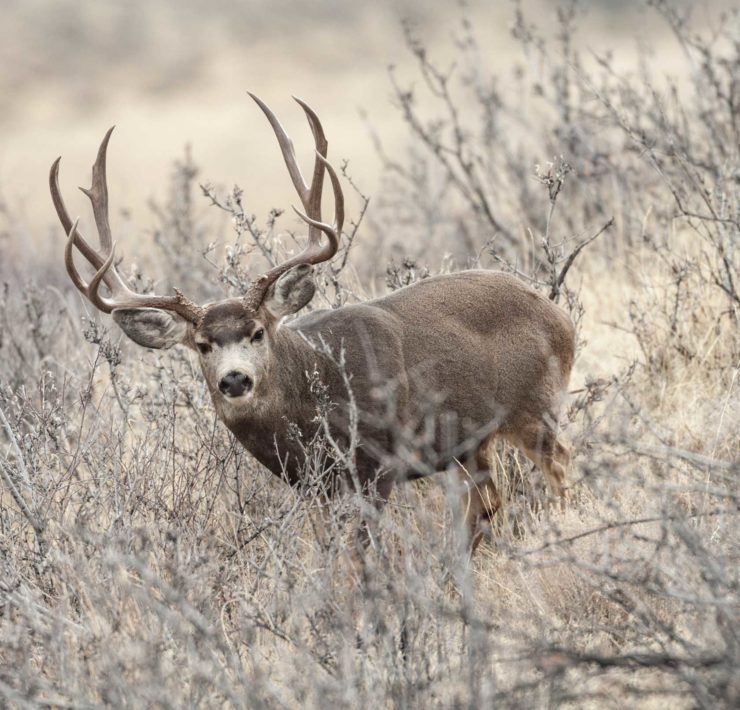New Mexico State Spotlight
The Mule Deer Foundation is the only conservation group in…
State Spotlight: New Mexico
When you think of game species in the western states, the mule deer has become an iconic representation of western hunting and heritage. New Mexico holds what are considered by some to be two sub-species – the northern population of desert mule deer and southern population of Rocky Mountain mule deer. With a large distribution and popularity among hunters of all ages and backgrounds, mule deer are undoubtedly one of the most economically and socially significant animals in our state.
A survey conducted by the New Mexico Department of Game and Fish (NMDGF) in 2014 reported that 87,000 individuals participated in hunting activities in New Mexico generating $345.5 million dollars. The economic contributions of hunters and anglers support habitat conservation and safety programs and also provide an economic boost in rural areas where sportsmen and women go to recreate. Hunters and anglers support more than 7,900 jobs in the state, providing valuable income to families directly and indirectly involved in the outdoors industry. The social benefit of hunting activities encouraged hunters to spend 927,000 days in the field.
Hunting in New Mexico is both culturally significant and economically beneficial, and because mule deer are such a reliable species to hunt in this state, it is critical to engage the people who enjoy the presence of this species to preserve the legacy of this icon in New Mexico. Unfortunately, mule deer are the one big game species in North America that is on the decline. In the 1960’s, mule deer numbers in New Mexico hit their peak of around 300,000 animals. But according to NMDGF big game biologist, Stewart Lily, recent estimates show a population of 80,000 to 100,000 animals, with variations in density in different areas of the state.
So what is impacting mule deer populations in New Mexico, you wonder, and how can you help? Hopefully this article will provide you with a little insight on what progress is being made in the state and with the growing activity of MDF.
Factors Impacting Mule Deer Success in New Mexico
Let’s start with habitat, because without it there would be no deer populations. Mule deer habitat is a constant changing factor that can influence deer populations and distributions. New Mexico mule deer habitat is unique because there are three ecoregions represented in the state: Colorado Plateau, Great Plains and Southwest Desert. Each ecoregion differs and must be understood and managed accordingly, presenting challenges to biologists and hunters. Improving habitat quality in the Southwest Desert can be as simple as increasing water availability, whereas decreasing dense canopy cover can be considered a benefit to areas of the Colorado Plateau. The severe drought in recent years has been a challenge to the habitat native wildlife relies upon for survival. Moisture is critical for wildlife survival and according to Lily the mule deer populations in the Guadalupe and Sacramento regions of the state are of high concern.
New Mexico has had its fair share of severe wildfires across the state the past few years, compromising the quality of mule deer habitat and mule deer numbers shortly before hunting season. However, burned areas can benefit several big game species depending on when the fire occurred, the severity of the burn and what kind of range was burned. Regrowth of vegetation, along with volunteer help in replanting native species in the burn area can provide enough nutritional support to reestablish a population. Over time, this “reset” in the successional clock can increase the body condition of bucks and does as well as breeding activity in the area. It can also help improve protective cover for fawns. For early fires occurring in May or June, hunters can expect to see mule deer activity return to the area in time for hunting season. Severely burned areas reach their maximum benefit around seven years after a fire but can be hunted three to five years after the burn occurred.
New Mexico is home to predator species such as bear, mountain lion, bobcat and coyote that also influence mule deer populations. The most vulnerable time of year is during fawning season when their prey is small and easy to catch, which is why vegetative cover is so important for fawn survival. The influence of predators on mule deer populations is also based on the abundance of alternative prey species and the frequency of additional predator species in the mule deer range. Predator control is effective at improving mule deer populations when predation is identified as a limiting factor, when deer populations are below habitat carrying capacity, and when implemented before fawning season.
Areas that do not have high or stable mule deer populations such as the Pelloncillo and Caballo Mountains have recently been a part of a series of transplant efforts by NMDGF that are being studied by New Mexico State University. Transplanting problematic deer from high density, urban habitats gives the agency a population that needs to be managed by being removed and moves them to supplement a population that needs to see growth. Similar relocation efforts will soon get underway in the Rio Grande del Norte National Monument. In a collaborative effort there, the Bureau of Land Management (BLM) and NMDGF plan to release 50-60 mule deer onto the Taos Plateau and monitor them using real-time GPS collaring systems. This study will focus on the utilization of mule deer habitat, winter range areas, fawning sites and travel patterns. After several habitat improvement projects by the BLM and NMDGF, this project is set to move forward in February 2015.
The Progress of MDF in New Mexico
To ensure that habitat is managed to benefit mule deer, collaboration between state and federal agencies as well as landowners must be established as well as maintained. The majority of mule deer habitat in New Mexico is on state and federal lands, allowing sportsmen and women to lend a helping hand in conservation efforts.
So how can you help shift deer numbers back to growing populations? Get involved with the Mule Deer Foundation! Ensuring the conservation of mule deer, black tailed deer and their habitat is MDF’s mission and we’ve been working with state and federal agencies to make a difference here in New Mexico and across the West. We have a team of volunteers across the state that helps local chapters and communities raise funds to support MDF and mule deer related conservation projects or educational programs in their region.
New Mexico is currently home to six chapters: the Duke City Chapter in Albuquerque and the Silver City and Roswell chapters. Duke City Chapter Chair Kevin Dolan is kicking off the chapter with a bang. In addition to preparing for their info booth at the HAWGZ Outdoor Expo May 29-31, their inaugural annual banquet is planned to take place on August 8th. This is going to be a “go big or go home” kind of event according to Chapter Co-Chair, Chris Lucero, so I can’t wait to see what the sportsmen and women in Albuquerque can pull together! The Tri-County chapter, encompassing Otero & Dona Ana Counties as well as El Paso County in Texas, held their 3rd annual Chapter Banquet on February 28th in Sunland Park, NM. We are also revitalizing the Farmington and Roswell chapters and recently welcomed on board the Lincoln County chapter. We have some great volunteers in these areas that need your help supporting mule deer in New Mexico and joining the committee efforts. Don’t have a chapter in your area? No problem, we can fix that! If you are interested in any MDF efforts in your area, please contact myself or Regional Directors Terry Herndon or Charlie Stockstill.
One of the most rewarding parts of having a MDF chapter in your community is the ability to give back to conservation and education programs that directly benefit mule deer and all wildlife within our diverse ecosystems. The Roswell and Tri-County Chapters have utilized their chapter rewards dollars to positively impact mule deer habitat on public lands. The Roswell chapter provided over $12,000 to help the BLM and NMDGF construct two wildlife water guzzlers. The Tri-County chapter has used more than $3,200 in chapter resources to support a water guzzler project with BLM and recently helped fund mule deer habitat and mountain lion predation research at New Mexico State University.
After learning more about mule deer and their habitat you may be asking yourself, “How can someone like me make a difference?” Well the answer is simple, get involved and speak up. Donating your time, your money and even your expertise is invaluable to those who work every day to secure prime wildlife habitat and ensure that our privileges as sportsmen continue. Thanks to dedicated volunteers as well as state and federal wildlife programs, New Mexico wildlife and habitat has benefited from water tank installments, forest road repair, replanting of seedlings in burn areas, and trash and debris pickup. Our public lands are one of our most cherished resources that have been passed down to us from the generations before us. It is the responsibility of all sportsmen and women to contribute to the success of New Mexico’s wildlife, their habitats and its use for future generations. Being active with the Mule Deer Foundation can help you make a difference!
State Chair- Colleen Richardson email: tricountymuledeer@yahoo.com
Regional Directors: Terry Herndon (Western NM) therndon@muledeer.org & Charlie Stockstill (Eastern NM) charlie@muledeer.org
The Mule Deer Foundation is the only conservation group in North America dedicated to restoring, improving and protecting mule deer and black-tailed deer and their habitat, with a focus on science and program efficiency. MDF is a strong voice for hunters in access, wildlife management and conservation policy issues. MDF acknowledges regulated hunting as a viable management component and is committed to recruitment and retention of youth into the shooting sports and conservation. Get involved in your state or become a member at www.muledeer.org or call 1-888-375-3337.



